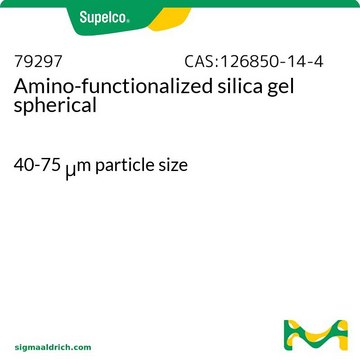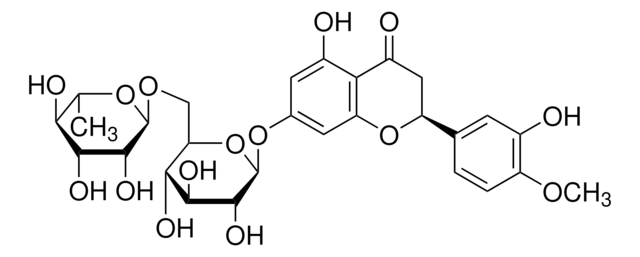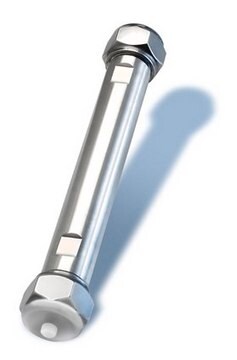Wichtige Dokumente
569232-U
Discovery® C18 (5 µm) HPLC Columns
L × I.D. 12.5 cm × 4.6 mm, HPLC Column
Synonym(e):
Discovery RP18 HPLC Column
About This Item
Empfohlene Produkte
product name
Discovery® C18 HPLC-Säule, 5 μm particle size, L × I.D. 12.5 cm × 4.6 mm
Materialien
stainless steel column
Qualitätsniveau
Agentur
suitable for USP L1
Produktlinie
Discovery®
Leistungsmerkmale
endcapped
Hersteller/Markenname
Discovery®
Verpackung
1 ea of
Kennzeichnungsgrad
12% Carbon loading
Parameter
≤70 °C temp. range
400 bar pressure (5801 psi)
Methode(n)
HPLC: suitable
LC/MS: suitable
L × ID
12.5 cm × 4.6 mm
Oberflächenbereich
300 m2/g
Oberflächendeckung
3 μmol/m2
Verunreinigungen
<10 ppm metals
Matrix
silica gel, high purity, spherical particle platform
fully porous particle
Aktive Matrixgruppe
C18 (octadecyl) phase
Partikelgröße
5 μm
Porengröße
180 Å
operating pH range
2-8
Anwendung(en)
food and beverages
Trenntechnik
reversed phase
Suchen Sie nach ähnlichen Produkten? Aufrufen Leitfaden zum Produktvergleich
Verwandte Kategorien
Allgemeine Beschreibung
Anwendung
- Rat Pharmacokinetics and In Vitro Metabolite Identification of KM-819, a Parkinson′s Disease Candidate, Using LC-MS/MS and LC-HRMS.: This study underscores the utility of theDiscovery® C18 HPLC Column in pharmacokinetic profiling and metabolite identification of a novel therapeutic agent, demonstrating its critical role in the development of Parkinson′s disease treatments (Choi et al., 2024).
- Determination of 2,4-dimethylhydroxybenzene by chromatographic methods in forensic toxicological research of biological material.: Highlights the application of the Discovery® C18 HPLC Column in forensic toxicology, enhancing the detection and quantification of toxic substances within biological samples, vital for legal and medical investigations (Chernova et al., 2024).
- High-throughput microfluidic chip with silica gel-C18 channels for cyclotide separation.: Illustrates the integration of the Discovery® C18 HPLC Column in a microfluidic setting for efficient and high-throughput separation of cyclotides, offering advancements in peptide and protein analysis (Ebrahimi et al., 2023).
- Priestia megaterium Metabolism: Isolation, Identification of Naringenin Analogues and Genes Elevated Associated with Nanoparticle Intervention.: This research utilizes the Discovery® C18 HPLC Column for the advanced study of microbial metabolism under nanoparticle intervention, pushing the boundaries of biotechnological and pharmaceutical research (Al-Theyab et al., 2023).
- A practical strategy enabling more reliable identification of ginsenosides from Panax quinquefolius flower by dimension-enhanced liquid chromatography/mass spectrometry and quantitative structure-retention relationship-based retention behavior prediction.: Demonstrates the versatility of the Discovery® C18 HPLC Column in complex botanical analyses, particularly in enhancing the reliability of ginsenoside identification, crucial for the development of herbal medicinal products (Sun et al., 2023).
Leistungsmerkmale und Vorteile
- Ausgezeichnete Reproduzierbarkeit
- Hervorragende Peakform bei basischen und sauren Analyten
- Stabile, gering blutende LC/MS-Trennungen
- Trennung von Peptiden und kleinen Proteinen
- Geringere Hydrophobität als viele vergleichbare C18-Säulen für schnellere Analysen
Rechtliche Hinweise
Sie haben nicht das passende Produkt gefunden?
Probieren Sie unser Produkt-Auswahlhilfe. aus.
Vorsäulenkartusche
Ähnliches Produkt
Hier finden Sie alle aktuellen Versionen:
Besitzen Sie dieses Produkt bereits?
In der Dokumentenbibliothek finden Sie die Dokumentation zu den Produkten, die Sie kürzlich erworben haben.
Verwandter Inhalt
Discovery C18 and C8 HPLC Columns products offered
Unser Team von Wissenschaftlern verfügt über Erfahrung in allen Forschungsbereichen einschließlich Life Science, Materialwissenschaften, chemischer Synthese, Chromatographie, Analytik und vielen mehr..
Setzen Sie sich mit dem technischen Dienst in Verbindung.








